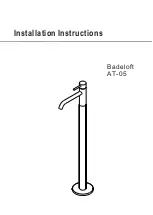
7
C-4) Electrical Connections:
C-4.1) Power & Control Cords:
The cord assembly mounted to the pump must not be
modifi ed in any way except for shortening to a specifi c
application. Any splice between the pump and the control
panel must be made in accordance with all applicable electric
codes. It is recommended that a junction box, if used, be
mounted outside the sump or be of at least Nema 4 (EEMAC-
4) construction if located within the wet well.
DO NOT USE
THE POWER OR CONTROL CORDS TO LIFT PUMP.
NOTE: The White Wire Is Not A Neutral Or Ground Lead.
The Black, White And Red Leads Are Power Carrying
Conductors. The Green Lead Is For Connection To
Ground.
C-4.2) Overload Protection :
C-4.2-1) Three Phase -
The normally closed (N/C) thermal
sensor is embedded in the motor windings and will detect
excessive heat in the event an overload condition occurs.
The thermal sensor will trip when the windings become too
hot and will automatically reset itself when the pump motor
cools to a safe temperature. It is recommended that the
thermal sensor be connected in series to an alarm device to
alert the operator of an overload condition, and/or the motor
starter coil to stop the pump. In the event of an overload, the
source of this condition should be determined and rectifi ed
immediately.
DO NOT LET THE PUMP CYCLE OR RUN IF
AN OVERLOAD CONDITION OCCURS !
C-4.2-2) Single Phase -
The type of in-winding overload
protector used is referred to as an inherent overheating
protector and operates on the combined effect of temperature
and current. This means that the overload protector will trip
out and shut the pump off if the windings become too hot,
or the load current passing through them becomes too high.
It will then automatically reset and start the pump up after
the motor cools to a safe temperature. In the event of an
overload, the source of this condition should be determined
and rectifi ed immediately.
DO NOT LET THE PUMP CYCLE
OR RUN IF AN OVERLOAD CONDITION OCCURS !
NOTE:
Single phase pumps can be orederd with an optional
Thermal Sensor as well as the standard in winding overload
protection.
C-4.3) Moisture Sensors:
A normally open (N/O) detector is installed in the pump
seal chamber which will detect any moisture present. It is
recommended that this detector be connected in series to an
alarm device or the motor starter coil to alert the operator that
a moisture detect has occurred. In the event of a moisture
detect, check the individual moisture sensor probe leads for
continuity
, ( ∞ resistance = no moisture ) and the junction
box/control box for moisture content. The above situations
may induce a false signal in the moisture detecting circuit. If
none of the above test prove conclusive, the pump(s) should
be pulled and the source of the failure identifi ed and repaired.
IF A MOISTURE DETECT HAS OCCURRED SCHEDULE
MAINTENANCE AS SOON AS POSSIBLE.
C-4.4) Wire Size:
Consult a qualifi ed electrician for proper wire size if additional
power cable is required. See table for electrical information.
TEMPERATURE SENSOR ELECTRICAL RATINGS
Volts
Continuous
Amperes
Inrush
Amperes
110-120
3.00
30.0
220-240
1.50
15.0
440-480
0.75
7.5
600
0.60
6.0
SECTION: D START-UP OPERATION
D-1) Check Voltage and Phase:
Before operating pump, compare the voltage and phase
information stamped on the pump identifi cation plate to the
available power.
D-2) Check Pump Rotation:
Before putting pump into service for the fi rst time, the motor
rotation must be checked. Improper motor rotation can
result in poor pump performance and can damage the motor
and/or pump. To check the rotation, suspend the pump
freely, momentarily apply power and observe the “kickback”.
“Kickback” should always be in a counter-clockwise direction
as viewed from the top of the pump motor housing.
D-2.1) Incorrect Rotation for Three-Phase Pumps:
In the event that the rotation is incorrect for a three-phase
installation, interchange any two power cable leads at the
control box.
DO NOT
change leads in the cable housing
in the motor. Recheck the “kickback” rotation again by
momentarily applying power.
D-2.2) Incorrect Rotation for Single-Phase Pumps:
In the unlikely event that the rotation is incorrect for a single
phase pump, contact a Barnes Service Center.
D-3) Start-Up Report:
Included at the end of this manual is a start-up report sheet,
this sheet is to be completed as applicable. Return one copy
to Barnes and store the second in the control panel or with
the pump manual if no control panel is used. It is important to
record this data at initial start-up since it will be useful to refer
to should servicing the pump be required in the future.
D-3.1) Identifi cation Plate:
Record the numbers from the pump identifi cation plate on
both START-UP REPORTS provided at the end of the manual
for future reference.
D-3.2) Insulation Test:
Before the pump is put into service, an insulation (megger)
test should be performed on the motor. The resistance values
(ohms) as well as the voltage (volts) and current (amps)
should be recorded on the start-up report.
D-3.3) Pump-Down Test
:
After the pump has been properly wired and lowered into the
basin, sump or lift station, it is advisable to check the system
by fi lling with liquid and allowing the pump to operate through
its pumping cycle. The time needed to empty the system, or
pump-down time along with the volume of water, should be
recorded on the start-up report.
Содержание 4SE-HL Series
Страница 16: ...16 FIGURE 10 4SEU Models ONLY 4SE 4SEU Pump Series...
Страница 17: ...17 FIGURE 11 4SE 4SEU Pump Series...
Страница 21: ...21 4SE HL High Ef ciency Pump Series FIGURE 12...
Страница 22: ...22 4SE HL High Ef ciency Pump Series FIGURE 13...








































